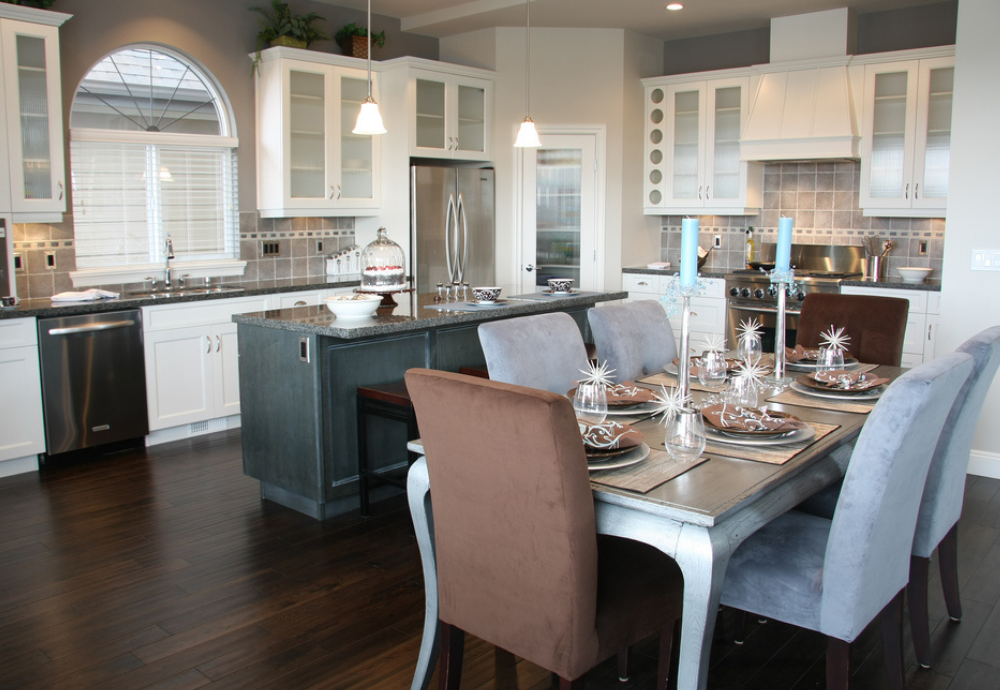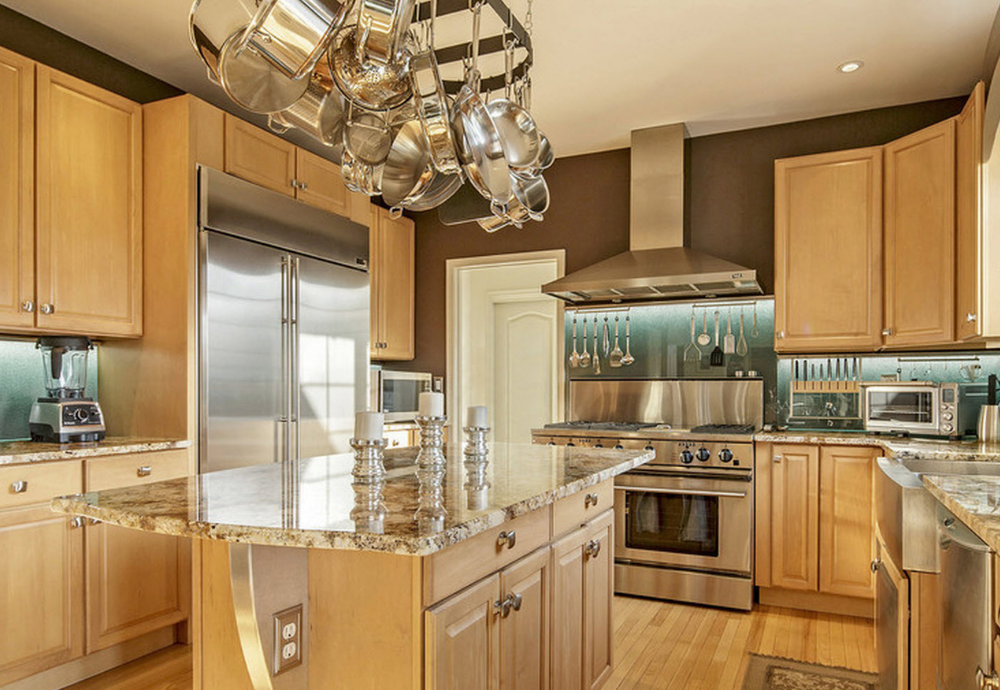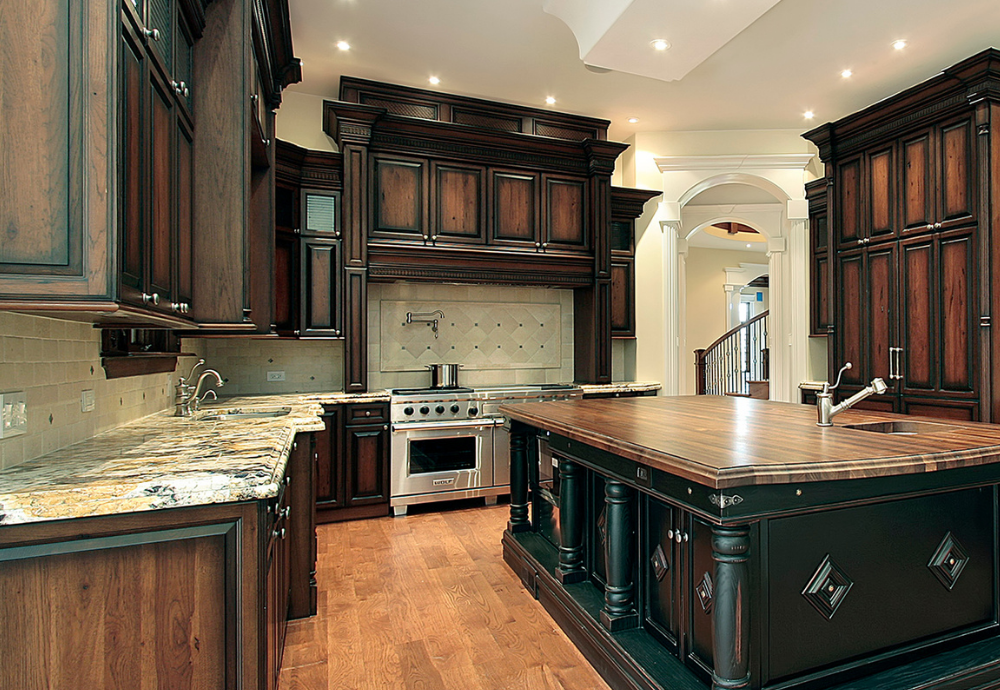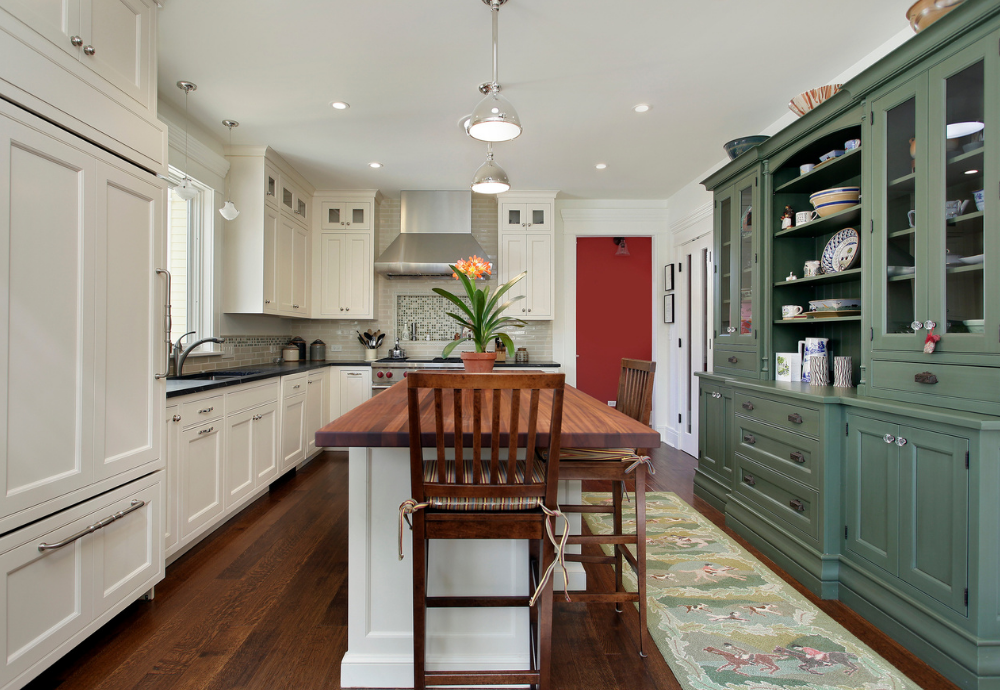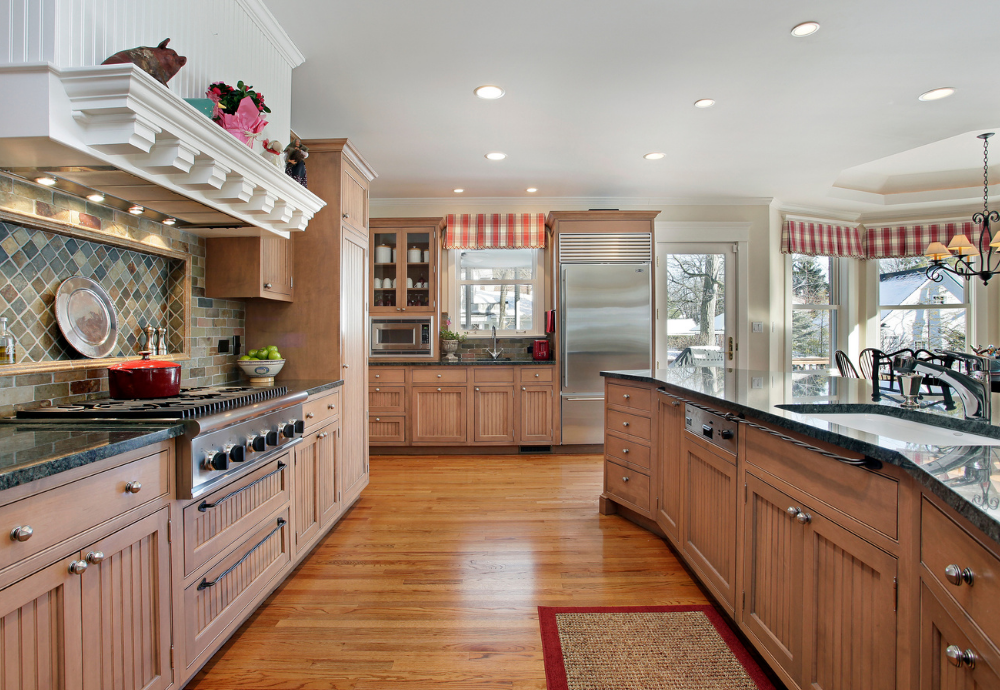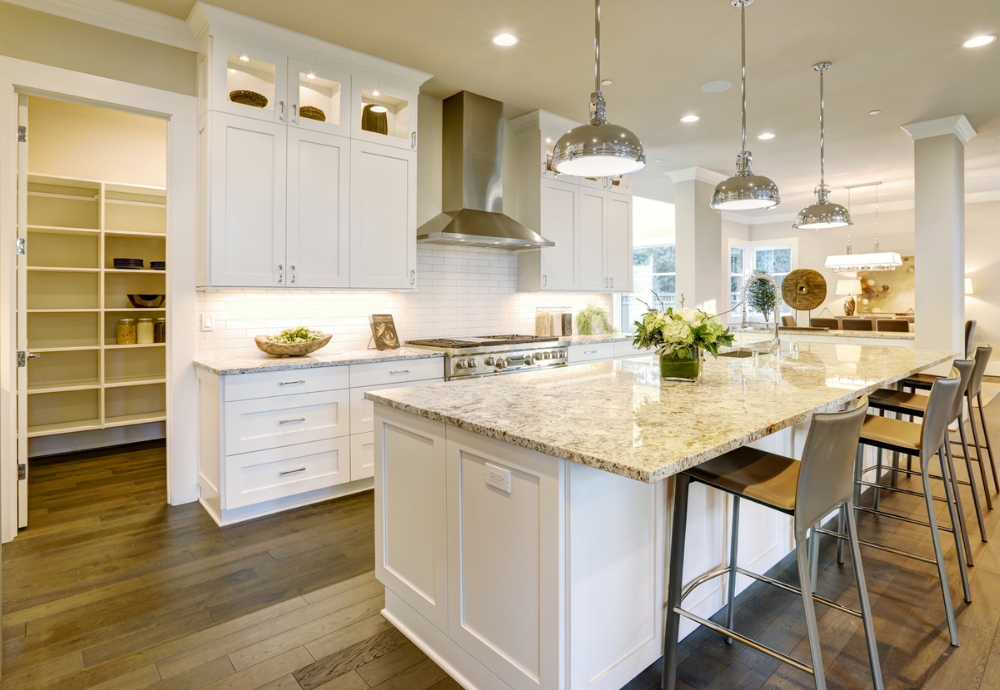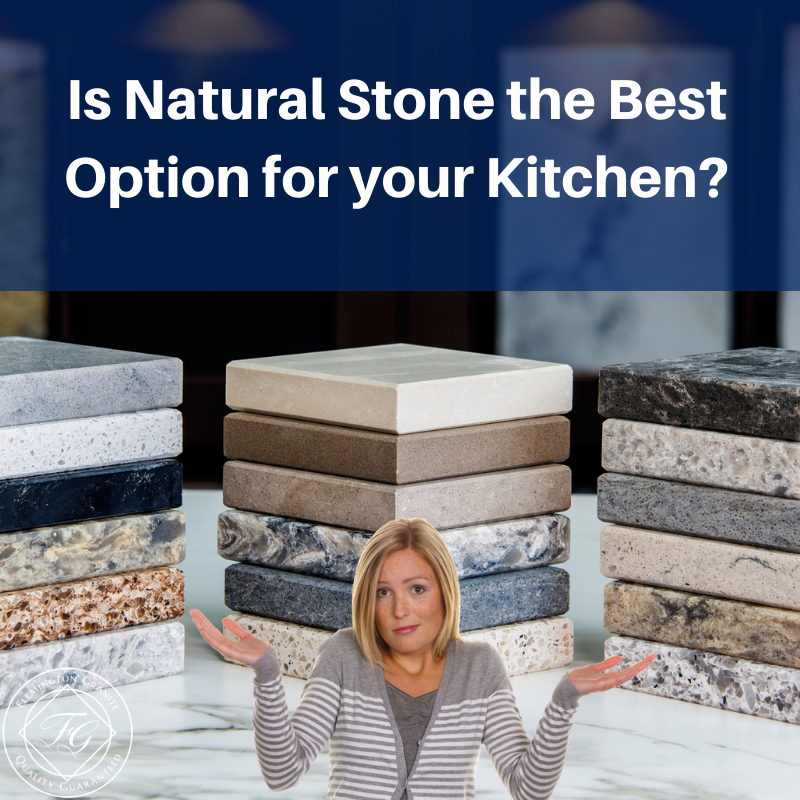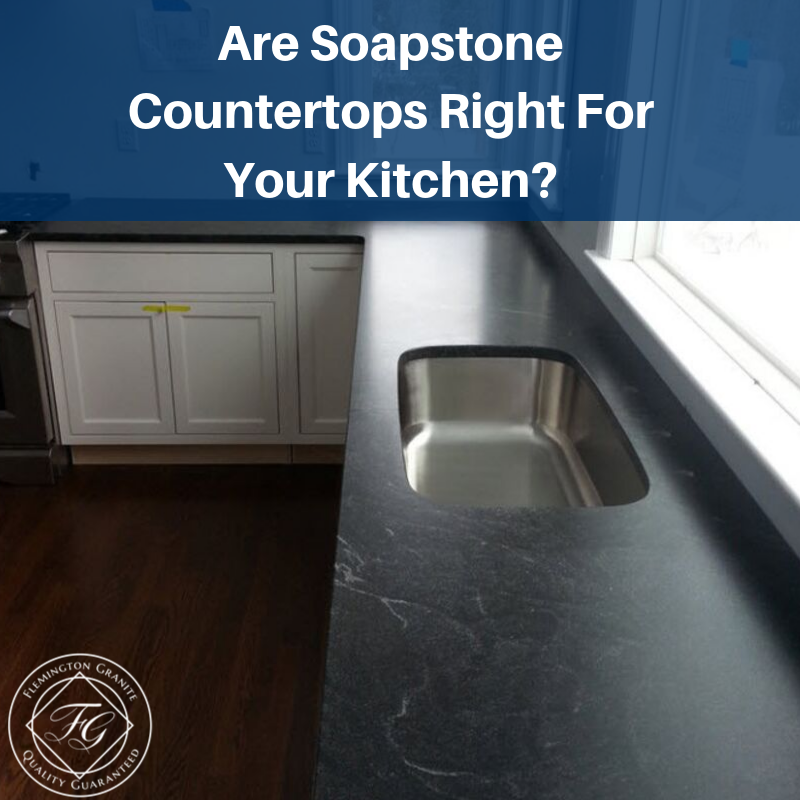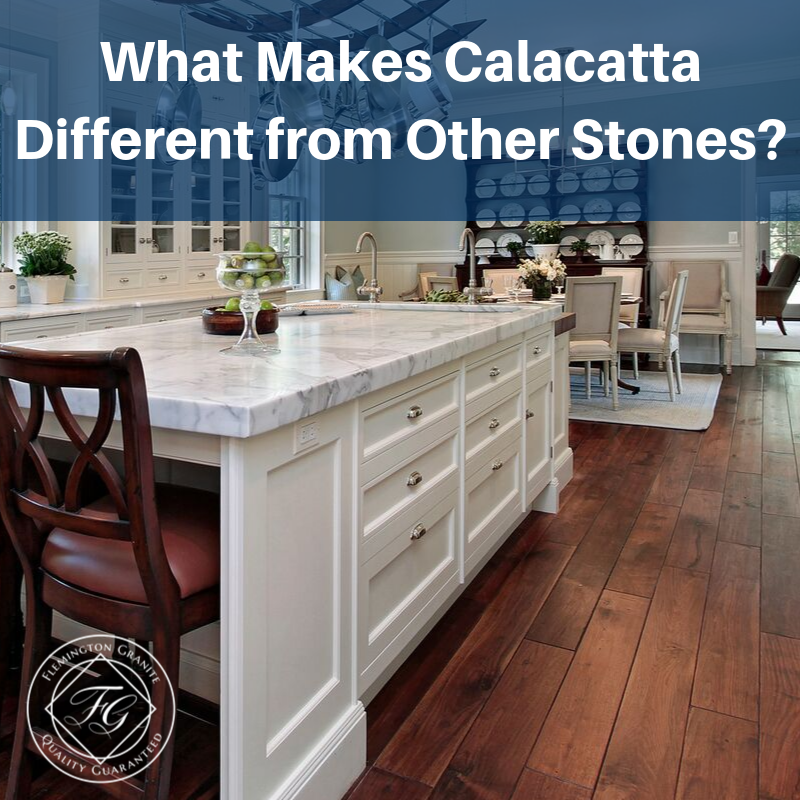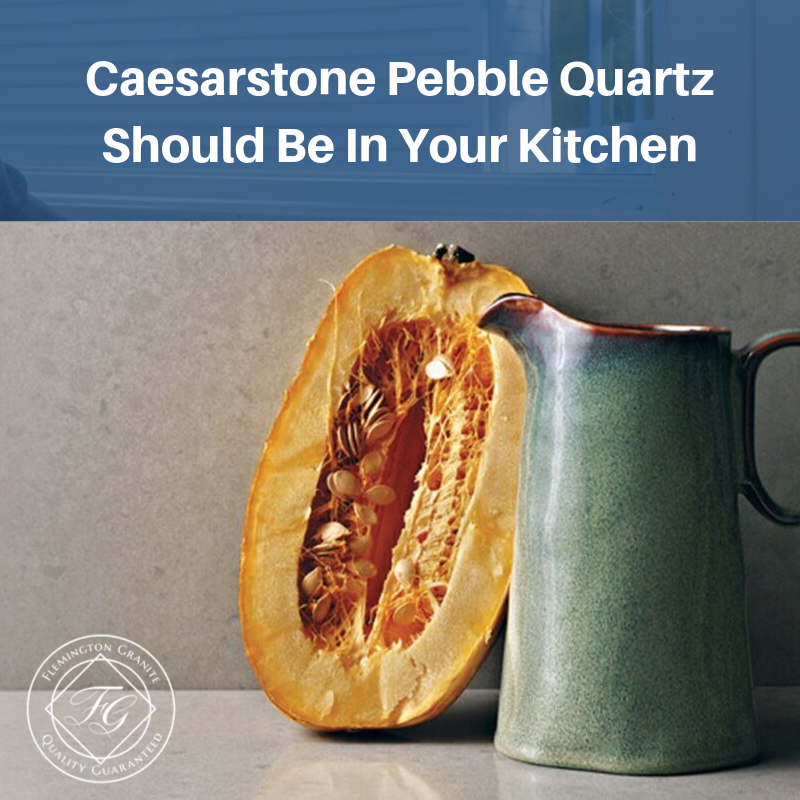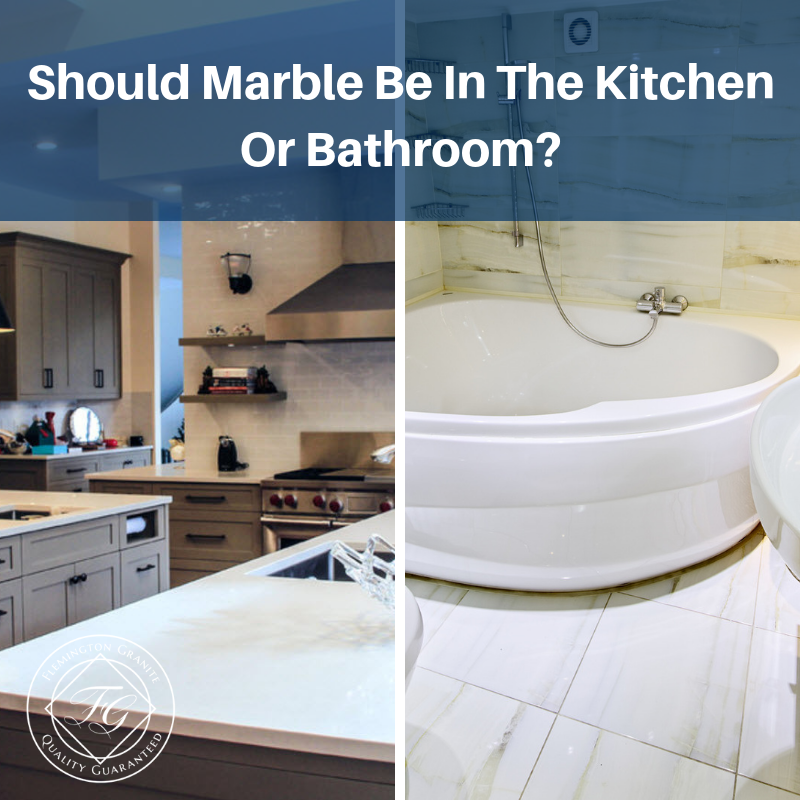A permit is more than just a way for your local government to collect fees, they help to ensure safety and with conserving energy by regulating construction.
Proper permits are essential when you need to sell your home. Not having them can make the sale process more complicated and can even cancel it in some cases. Failing to get the proper permits can cause issues during a remodel including work delays and the need to redo work that has already been completed.
The Benefits of Natural Stone for Kitchen Remodeling
How To Prepare For A Kitchen Remodel
For the homeowner, kitchen remodels are among the most challenging forms of home improvement. The kitchen is often said to be the heart of the home because of how central the room is to family life. Family life tends to be disrupted when it is out of commission.
A kitchen remodel should involve a plan to manage the period of construction ahead. How long it will take depends on the project’s scope. How much do you intend to change? Do you want a new kitchen with the same footprint or do you want a completely new design?
If you are keeping the footprint, remodeling shouldn’t take more than six weeks at most; if you are making significant alterations, it might take up to three months. In either case, you will need to get yourself and members of your household ready for it. Here are some tips to help you prepare for a kitchen remodel:
Look at Designs Before the Project Begins
Consult an architect before you start moving walls. You need to make sure that your kitchen will function correctly. Your design should include adequate storage space and account for the ways to position appliances for maximum efficiency. Your architect will be able to spot any problems in your design. You should also get a timeline for the project from your contractor. Before your remodel begins, you should know exactly how long it will take. A timeline will also tell you how long you will have tradespeople going in and out of your home.
Choose the Right General Contractor
Your general contractor will be responsible for hiring the tradespeople for the project. You will be communicating with them about the project, so you need to find someone who will return calls and texts quickly.
Make Plans for Meal-Times
One option for living without a kitchen is to cook some or all of your meals in advance of the project’s start.
If you and your family normally eat in the kitchen, decide where you are going to eat once the remodel is underway. Consider your living-room if that’s what you’ve decided to use as your temporary kitchen. If you have a patio or deck, that can work too.
Get paper plates, plastic cutlery and cups so that you don’t have to wash your regular cutlery and dishes in the bathroom.
Come up with a budget for eating out at least a few nights a week while your kitchen is being remodeled. Planning ahead is important since this can get expensive quickly, especially if you have a large family. Factor the cost of eating out into the overall cost of your remodel.
Make Another Room Into Your Interim Kitchen
If you have space, use another room in your home as a short-term kitchen. Options include moving your refrigerator to your living room or your dining room. If space is limited, get a smaller refrigerator and microwave and plug those in somewhere else in your home. If you can’t devote a whole room or even half of a room, consider distributing essential kitchen appliances throughout your home.
Get an electric griddle to stand in for your stovetop, or invest in a hot plate. Plan a few meals that you can cook in a crockpot. All of these appliances can work wherever you have an electrical outlet. Another option is to use your outdoor grill. You can grill food on it and you can use it as a stove.
If you have a lot of small appliances and other items that you don’t plan to use before the remodel is finished, pack them away in boxes. Remember to use packing peanuts or bubble wrap for items like china and glasses. Store the boxes away in your spare bedroom or basement and be sure to label them. Labeling makes unpacking easier and reminds you which boxes contain breakables.
Seal Off the Kitchen
Anyone who has ever lived through a remodel will tell you that they are not tidy. You will need a plan for keeping the rest of your house clean all the way through until the project is complete. Sealing off your kitchen can help to minimize the spread of dust and dirt to the rest of your home.
Get the Kitchen Ready
If you plan on doing the demolition yourself start with the following: disconnect the gas from your range and electricity from any of your hard-wired appliances such as ovens and dishwashers. Do your light fixtures have glass covers? If so, remove them. Remove covers over your electrical outlets as well. Heat register and window covers should all be removed.
Move all of your appliances out of the kitchen. If you have a vessel sink that sits above the countertop, lift it out and remove the faucet. Take out the backsplash and countertop. If you have wall tiles, those have to go too. Use a drill or pry bar to remove cabinets. Use a pry bar to pull drywall off the ceiling and walls but be careful around electrical wiring and ductwork. If there is no asbestos in the floor, pull up the linoleum of other flooring and then finish it all up by cleaning up the waste and dust.
Make Plans for Pets
A remodel can be stressful for pets. Not only will they kept out of the kitchen while it is under construction, but there will also be new loud noises and strangers going in and out. You may want to find them temporary homes or at least kennel them as far as possible from the kitchen.
If you are planning to remodel your kitchen, planning and preparation are crucial for getting through the process. We can help. Use our contact form to reach out to us.
How to choose the right contractor for my kitchen remodel
Thinking about a kitchen remodel can be a daunting task, especially if you don’t have a plan in place. One sensible and organized way to solve any kitchen remodeling dilemma is to choose the right contractor for the job. Finding the right one can be frustrating as it seems that almost everyone has horror stories about dealing with contractors who leave remodeling projects unfinished, or abandon them altogether. Fortunately, there are reputable contractors out there. The question is how do you find one who knows what they’re doing. Here are some ways to locate the right contractor for your kitchen remodel job.
Plan it Out
Before you even connect with a contractor, know exactly what you want done with your kitchen remodel. Be specific with a general written plan and layout of the space or spaces that will be affected as well as what you want the area to look like, and what materials will be needed. Whatever your lifestyle, and how it relates to your kitchen should play a major part in your plan. You want a kitchen remodel that is going to accommodate the kind of time you spend in the kitchen.
Recommendations
Sometimes the best sources for reliable contractors are recommendations and references found through family, friends, neighbors, co-workers, social media connections or those working in construction or related building trades. Ask them what their experiences have been with contractors who have either done work for them, or for others. Hardware and home store employees may also be able to be of help in providing referrals for local contractors.
Research
Once you find contractors and company names, do some research online or through the Better Business Bureau, and any other reporting agencies as well as any disciplinary boards that govern contractors. Also, check on general contractor licenses and subcontractor licenses in your area along with any possible complaints or litigation proceedings that may have occurred with any of them.
When you do engage a contractor, get a copy of his or her license and copies of licenses of any of the major subcontractors who will be on the job. Also, concerning subcontractors, ask the general contractor what work will be done by subcontractors and other company employees. Ask for a listing of employees who will be working on your remodel so you know who is coming and going from your home.
Communicator
One important aspect in your contractor search is connecting and communicating with one who not only specializes in kitchen remodels but converses with you easily and comfortably. You want to know as soon as possible whether a particular contractor is going to be the right fit for your remodeling situation. Since you are likely to be working closing with him or her, you want to be on the same wavelength and interact without major conflicts or difficulties during the remodeling process.
Contractor Contact
Once you have found at least three reliable and verifiable contractors, set up a consultation/interview with each one. Have a list of any questions that come to mind concerning your kitchen remodel. For added assurance as to the quality of a contractor’s work, ask each one for samples or a portfolio of their past work, particularly with previous kitchen remodels.
After the interviews, get a bid in writing from all three. Compare the bids and make a point to include any and all materials and actual tasks to be performed. That way you can compare all thee and determine any discrepancies among them and make an informed decision as to the contractor you want to use. You can negotiate as to the bids made at this stage, but any serious changes will likely occur once you secure a bid and before you sign a contract.
Busy Contractor
Other indications of an expert and trustworthy contractor are not only their verifiable references and expansive portfolios, but their level of business. Most better than average contractors are busy on a regular basis and would likely be unable to start your remodeling project right away.
Contract
Now that you have chosen a contractor, you’re ready to get down to brass tacks in a signed contract, but before signing on the dotted line, you want to make sure that every aspect of your contract specifically states what will be done with your kitchen remodel. Deadlines should be included as well as payments for work completed and exact materials for use. A comprehensive contract is important but if you feel that anything has been omitted or changes need to be made, write up your own additions or change orders to include any other work, costs and materials. Whatever you do, don’t sign a contract for the entire amount of the remodel budget. There are almost always going to be added costs that will pop up during the middle or end of a remodel. So, you want to be prepared for at least a 10-15% increase over your contract.
Payments
At the beginning of your contract you don’t want to advance more than 10% of the total costs for the remodeling job. Your original contract should include a progression of payments and a payment schedule. You want your money to remain on your project and not be used to complete a contractor’s job elsewhere; however, if more costly materials are needed right away, a larger advancement (of up to 30%) may be necessary.
Permits
One really important job responsibility of your contractor is to acquire any permits that are required with a kitchen remodeling project. Most any renovation or remodeling jobs do require permits. Some contractors will suggest overlooking the permit process because of the cost, but that means violating ordinances and making yourself subject to fines. Any work completed needs to be inspected by a city or country inspector to make sure that the work has been completed according to code. You don’t want your kitchen remodel to be under violation because of work that hasn’t been permitted. The lack of permits can be problematic when a homeowner thinks about selling or leasing their home.
Documents and Receipts
Always get any receipts for materials and other products from your contractor, and keep a record of them. Also, acquire copies of lien releases from the general contractor and any subcontractors before you make any progress payments, or other payments. If a contractor doesn’t pay subcontractors or other employees, a lien could be placed against your home for nonpayment.
Insurance
Before initiating any remodeling project, confirm insurance coverage through your own homeowner’s policy as well as what would be covered through a contractor’s business insurance. Always get a copy of the contractors company insurance policy.
Final Payment
Obviously, it is critical that you don’t make final payment on your remodeling project until the job has been finished. Some contractors are known for moving away from one job and going on to another before the previous job has been completed. Make sure that the lien releases and receipts are in your possession as well before making final payment.
Your kitchen remodel can go smoothly if you choose the right contractor, and can verify their work and credentials. With a plan in mind and direct “contractor to homeowner communication,” you can have a successful kitchen remodeling experience. If you are still unsure of procedures to follow in acquiring an experienced and trustworthy contractor, complete the online contact form and an expert will get back to you with the answers you need to make an informed decision.
Things to Consider Before Buying New Cabinets
Cabinets are among the major features in kitchens and bathrooms and could account for about 50 percent of the total cost of your total remodeling budget. The cost and the fact that they are key components of your design is why setting a budget should be at the top of your priority list.
How much you invest your cabinets depends on factors like how long you will be living in your home. If you don’t plan to live there very long, you can choose a basic cabinet style; however, you may want to choose a more premium version if you are installing them in your dream home. If you plan to spend a lot on your cabinets, you should ensure that they have features like:
- Solid frames
- Soft-close drawers
- Reinforced corners and backs
View this post on Instagram
Before you make a decision, find out what you like. Look on home improvement websites and magazines to learn what’s available and what you like.
Factors to consider when choosing cabinets include:
- Sink and appliance sizes
- Wood quality
- Cabinet color
- The style of the front
- Hardware style and color
- Cabinet depth
- Countertop color and material
- Whether you want a backsplash or not
- Whether you want to pay for installation or demo
- Drawer organizers and other extras
How to Order Your Cabinets in a Home Improvement Store
Before you go to the store, you will need to gather some information so that you can order the right cabinets for your kitchen or bathroom. You will need to provide some measurements. You can get help from a professional or you can measure the space yourself. Note that some stores will measure the space for you at no cost if you agree to buy cabinets from them.
When you shop for cabinets at a home improvement store, you will usually meet with a store associate to discuss your kitchen plans. You will get to see their cabinet selection up close before they proceed to the next step, which is to bring your plans to life. Make an appointment for this consultation ahead of time to ensure that the store associate can give you their undivided attention.
Give the measurements to the associate at the store where you will purchase your cabinets. Having precise measurements means you will get a better understanding of how your cabinets will look once installed and how much they will cost.
Expect the associate to ask questions about the cabinets you are ordering. The answers you provide enable the associate to give you an even more accurate digital representation of your design along with a cost estimate.
View this post on Instagram
Stock vs. Custom vs. Semi-Custom Cabinets
Stock cabinets are the most affordable because they are fabricated in standard dimensions. If you decide to go with stock cabinets, your choices will be limited. Choose a style that complements your home’s interior design. The finishes you can choose from include natural wood in multiple colors as well as painted, stained or laminated cabinets.
You will get a greater range of options with custom and semi-custom cabinets. With a stock cabinet, you get drawers and cupboards but not much else. With custom and semi-custom cabinets, you have numerous storage solutions including lazy Susans and pull-out bins. Semi-custom cabinets offer a wider range of designs and you get to choose from a wide range of configurations, but they are still constructed in standard dimensions.
Custom cabinets are built to a designer’s specifications and can come in your choice of material.
Choosing Cabinet Materials
The most common materials are:
Wood
When it comes to cabinet doors, you can choose from wood and exotic wood. Common woods include oak. Cherry and maple. You can paint or stain wood cabinets. You can also choose from exotic woods like bamboo and mahogany. The differences in the woods include density and color. You will also have to decide whether you want a cabinet that looks like wood or you want a painted one.
The two wood options for the cabinet box are plywood and engineered wood with plywood being the more durable (but also more expensive). If you are working with a designer, get their input as to which would be better in your kitchen.
Acrylic
Acrylic cabinets consist of an acrylic veneer over a medium-density fiberboard (MDF) core. You can choose from a vast variety of colors and they are typically durable. Drawbacks include the fact that they can be pricey and you may have trouble keeping them clean. Acrylic doors are available as flat panel only.
Laminate
Like acrylic cabinets, you can find laminate in many colors. They are an affordable option but not as durable as other materials and only flat panel doors are available in laminate with no style variations.
Thermofoil
With Thermofoil, you get another cost-effective material that gives you an array of color options. Thermofoil consists of a vinyl veneer over MDF. The finish is easy to clean and you won’t be limited to flat panel.
Stainless Steel
While stainless steel does have a few cons such as cost and the potential for denting, they offer a long list of pros. Stainless steel can be attractive, durable and can make your kitchen look like a professional one. If treated, stainless steel will not corrode.
Cabinets greatly enhance the functionality of kitchens and bathrooms but shopping for them can be difficult. For help with your kitchen or bathroom renovation, use our contact form to get in touch with us.
The Best Kitchen Color Schemes
Warm neutral, bright and earthy colors are supposed to make kitchens feel more comfortable. Grays and whites are popular as well. Having the right color palette in your kitchen accomplishes many things; the color scheme helps you to coordinate your cabinets, reflects light for a more cheerful space. Perhaps most importantly of all, the right colors make your house more attractive to potential buyers.
The Rules of Kitchen Colors
View this post on Instagram
The rules of kitchen design state that blues, greens and purples are among the cold colors that do not promote hunger. As a result, many experts believed that they don’t work for kitchens. Keep in mind that the conventions also dictate that black doesn’t work in kitchens, but it can if you implement it correctly. For example, ways to use black include combining it with white and a pale gray to make your kitchen into a light and airy space. You can use matte black to offset light browns and create an effect to complement natural wood. Ultimately, any color can work as long as you recognize that you have an immense number of gradations to work with. It’s all a matter of your taste.
Warm Neutrals
View this post on Instagram
If you tint it enough, you can make any color into a warm neutral. You just have to add red, orange or yellow. If you want to cool them down add one of the cold colors.
Red
View this post on Instagram
Not everyone will want a red kitchen, but it can work if you want to make your kitchen look livelier. If you have a lot of dark colors, you can use reds to make the space less gloomy or as a counterbalance for the grayness of stainless steel appliances and other elements.
Brown
View this post on Instagram
Browns evoke the earth that produces all of our food. If you don’t want to use neutral colors, brown can be a safe option. Warmer reddish browns can make an attractive pairing with darker brown cabinets. You can also pair it with green, another color associated with food. You can use white to lighten a space dominated by the brown from a dark natural wood flooring. White works well with quartz or marble elements such as countertops and tiles.
Grays
View this post on Instagram
Dark gray can be a striking option in a kitchen design that lets in a lot of light. Gray also plays well with white, especially a very light gray. Use light gray in combination with white and aqua to create a lighter palette to offset darker countertops.
All White
View this post on Instagram
Kitchens with white walls, cabinets and ceilings are a distinctive style of kitchen. White-on-white is separate from all other styles. Making everything white — including floors, light fixtures and appliances — is an established aesthetic choice dating back to the early 20th century. If your cabinets are already white, why not go all the way by getting white countertops and chairs? If done well, the result can be a modern and sophisticated look.
Yellows
View this post on Instagram
The general consensus among homeowners and designers is that yellows that have been toned down are great in kitchens. Pale yellows are subdued enough to not be distracting but will also blend nicely with all kinds of woods. Yellow reflects a lot of ambient light and can help to dispel gloominess without making a space feel sterile as it might with white. A yellow that is pale enough to be called cream is a perfect complement to white elements in a kitchen such as a china display. Darker, more intense yellows bring to mind a more traditional kitchen but will reflect enough light to give a deeper tone.
Blue
View this post on Instagram
You won’t see blue on most lists of the best kitchen colors because it is not typically associated with food. There are not many truly blue foods. That said, you can use it to give your kitchen a retro look or as an accent. You can also use gradations of blue or teal to help your kitchen to fit in with the color scheme used in the rest of your house. You might find that a very light blue will change color throughout the day with the variations in exterior light. The blue color can transform from greenish-gray to a more silvery gray depending on the time of day.
The kitchen is one of the rooms that sell homes. Whether you are planning to sell your home or to live it in for a while, your kitchen’s color is important to how the room looks and feels. If you are planning to remodel your kitchen, choosing the right color is crucial. If you need help with planning the colors for your kitchen, reach out to us via our contact form.
How Long Does A Kitchen Remodel Take?
Few things can delight a homeowner as much as the prospect of remodeling their kitchen. Because of how much time we spend there, new appliances and finishes can make a significant difference in our quality of life.
The time it takes to complete a kitchen remodel project can vary considerably depending on how much you plan to do and a variety of other factors. Excluding the time it takes to plan and design the new kitchen, the average kitchen remodel lasts between four and six weeks. This is if the remodel is mostly cosmetic and involves no changes to the footprint.
A full renovation that requires that your plumbing and wiring be rerouted and changes to all appliances and finishes can take up to five months if the kitchen design is particularly complex.
Why do kitchen remodels take so long?
Each kitchen remodel is one-of-a-kind due to the coordination of various subcontractors, some of whom will be able to start work only after other tradespeople have performed their work. Much of the work will involve large and heavy materials that will be difficult to move. You can also expect the timeframe to change based on if you plan to change the footprint or not.
The Planning and Design Phase
Have a carefully considered plan for remodeling your kitchen before you go shopping for cabinets. Take a look at a variety of kitchen designs so that you can form goals and priorities and develop a vision for your kitchen. You will also need to calculate a budget for your remodel.
You should take your time with the planning and design of your new kitchen. Make sure that you are fully comfortable with it, which means that you should think carefully about what you want. Go over every detail ranging from cabinet styles to hardware. Your designer should be able to show you design options along with the associated costs so that you can decisions with your budget in mind. It is best to make changes during the planning phase instead of when the remodel is underway.
Designing your kitchen is the most enjoyable part of the remodeling process as this is when you get to choose your countertops and paint colors. You get to look at new appliances, flooring and cabinets as well.
The Steps Involved in Remodeling a Kitchen
The time frame for a kitchen remodel has to do with what is involved. The process of remodeling a kitchen (after completing planning and design) can be broken down into the following steps:
Demo:
In this step, you remove all elements of the old kitchen. Countertops, cabinets and flooring will all be taken out. The walls, ceilings and floors will all be checked. If no part of the structure needs to be corrected, the builders will move on to step 2.
Electrical Layout:
Outlets, wiring for appliances and the lighting will be positioned. All of the locations are measured and clearly marked for the electrician who will handle the installation.
Plumbing, HVAC and Electrical Installation:
The installation of pipes, ductwork and wiring can take several days since it involves multiple tradespeople.
Drywall, Insulation and Flooring:
Once the mechanical phase is over, insulation should be installed followed by the drywall.
Cabinets and Countertops:
The cabinets go in first and measurements for the granite countertops sent to the fabricator. The slab is prepared for installation and then delivered.
Finishing and Painting:
Plumbing fixture and backsplash installation are handled at this stage and finishes for hardwood floors are applied. This is also when the walls get painted.
Appliances and Cleanup:
The final stage involves hooking up appliances and cleaning up. Any necessary touch-ups can be handled at this point.
How to Expedite a Kitchen Remodel
The best way to speed up the process is to set a realistic budget from the start. Order all of the materials and products early in the process and provide your designers and contractors with the products before you start demolishing the old kitchen.
Homeowners should understand and accept that renovations will be noisy, messy and generally inconvenient. They involve strangers going in and out every day. The project will take longer if crews have to delay work because their presence is disrupting the homeowner’s lifestyle.
You should get your new appliances as soon as possible after you have decided on your budget. Your cabinets and the layout of your remodeled kitchen will be based on the appliances. If you get new appliances after the project has begun, this can cause serious delays since the layout will have to be adjusted.
In most cases, the period during which the kitchen will be unusable is fairly short. You shouldn’t have to go without your kitchen for more than six months; however, you should still make plans in case you are without a kitchen for longer than predicted.
Learn which products have long lead times such as custom cabinets, tiles and stone countertops. Order those products early so that they will be delivered to your home in time. Stock cabinets can be at the site within a week, custom cabinets take about eight weeks but it can take up to four months to build and ship custom cabinets to you.
If you want granite countertops, order them from a retailer where you can pick out the slab with the color and pattern that you like ahead of time.
If you are interested in having your kitchen remodeled and want to find out how to have the project completed as quickly as possible, communicate with us via our contact form.
Is Natural Stone the Best Option for your Kitchen?
When it comes time to remodel your kitchen or if you are building a new home, deciding the right countertops for your family can be difficult. Today, natural stone is one of the most popular types of counter materials yet even deciding which type of stone can be difficult. These advantages and disadvantages of natural stone as well as descriptions of the various types of stone countertops you can get, can help you make a better informed decision.
Resale Value
One of the biggest advantages to natural stone countertops is the luxurious look it gives your kitchen. When it comes time to sell your home, natural stone will be attractive to buyers due to its durability and minimal maintenance. Even if you don’t plan to sell your home soon, you want to create a kitchen that buyers will fall in love with so that when it is time to sell, you not only recover your investment but sell your home more quickly as well.
Durability and Food Prep Safety
When maintained properly, natural stone counters such as granite or quartz may actually last longer than any other feature in your home. Stone outlasts solid surface, laminate, tile and butcher block, retaining its beauty with very little maintenance. In addition, natural stone can handle even the busiest kitchen without looking worn or damaged. Most natural stones are heat and scratch resistant, unlike solid surface, butcher block or laminate. Because most natural stones are non-porous, they are highly sanitary as bacteria cannot accumulate in the surface. Even stones that are more porous than others, like marble, can resist bacteria if it is sealed properly and the seal is maintained. In addition, if you enjoy baking, marble is the perfect choice as the coolness of the stone works well with pastry.
Low Maintenance
Natural stones are very easy to maintain, requiring only mild soap and water for cleaning. There are some types of stone that require sealing, such as marble and soapstone. The sealant needs to be reapplied every few years. This is not a difficult task and it is possible you can apply the sealant yourself. There are special stone cleaners available that you apply periodically and buff until dry to keep your granite looking brand new. Although stone counters are difficult to scratch, it is important to always use cutting boards as the stone can actually damage your knives.
Granite Countertops
When deciding which stone to use for your counters, it is important to understand what some of the disadvantages of each stone may be. Granite, by far the most popular kitchen counter material, is extremely hard and difficult to scratch. It is porous, however, so it does need to be sealed periodically. If the seal is compromised, some foods could stain your counter. Granite is also only available in colors that can be created by nature and every slab of granite is different. If you have a large counter area, this could mean counters have different veining depending on how you stand in the room.
Quartz Countertops
Another countertop material that is growing in popularity are quartz counters. These are engineered stone countertops created from crushed quartz mixed with coloring and resins to create an extremely hard surface. Because it is engineered, it is available in a wide range of colors. Quartz does not need sealing like other types of natural stone. However, because the stone is mixed with resins, it is not as heat resistant. It is recommended that you always use hot pads and trivets to protect the surface. Many homeowners choose quartz over marble or granite because the stone has a warmer feel than other types of stone.
Marble Countertops
Marble has been used as a building material for centuries. It has a cooler feel than other types of stone which is why it is the perfect surface to work pastry. However, marble is a much softer stone than quartz or granite so it is susceptible to scratching and staining. Red wine, coffee, juices and citrus can damage the counter so spills need to be wiped quickly. Marble also needs to be sealed regularly as well.
Family Lifestyle
One thing to consider when choosing natural stone countertops is how the stone will work with your family. If you have a busy family, granite may be the best option due to its versatility and durability. Choosing a darker granite counter will also help hid stains and small scratches. If you have small children but really love the look of marble, you can find quartz counters that mimic that look but don’t have the staining or scratching issues that marble may have.
Choosing a Finish
Once you have selected the stone that will work best for your family, you will have to choose a finish. Polished stone requires the least maintenance and keeps its beauty the longest. Honed or brushed finishes can be difficult to maintain, especially if you are a busy cook. Some homeowners like the changes that occur in honed or brushed counters over time, thinking that the slight changes make the counters more unique.
Ask to See Individual Slabs
Keep in mind that, other than quartz, which is engineered, each natural stone slab will be different. You can ask to view several different slabs to get a feel for what will work best in your kitchen. A good installer will be able to place the slabs so the veining works well together. By having you look at individual slabs, the fabricator will get an idea what you are looking for when it is time to install.
If you are considering natural stone for your kitchen, contact us today to learn more. Our helpful customer service staff will walk you through the process so you know what to expect every step of the way. With decades of experience, we can create a kitchen that you will love for many years to come. Schedule an appointment today by filling out the easy online form or giving us a call.
Are Soapstone Countertops Right For Your Kitchen?
Stone countertops are an elegant and stylish way to accent your home with the beauty of nature. In most cases, a slab of polished stone looks much better than a slab of wood. More importantly, it will probably last much longer. But that still leaves us with one question: Which kind of stone to use?
Today, we will be taking a look at soapstone, which is one of the more popular choices. Our purpose is to help you determine if this kind of stone is right for your home. We will do this by evaluating the stone based on a set of important factors.
Factor 1: Price
Most of the time, soapstone tends to be cheaper than other stones like marble or granite. There are several reasons for its reduced cost, but most of it probably comes down to availability and convenience. Soapstone is very common throughout the world, much like granite. Unlike granite, it is fairly easy to cut and shape. This makes the mining process easier and cuts down the price.
But how much of a difference are we talking here? Let’s make a quick price comparison. We can search for prices on stone slabs, which will give us a good idea of the price per square foot. So, let’s compare marble, granite, and soapstone.
Here is a marble countertop that measures about 1×6 feet. Its cost is about $170. That comes out to $28 per square foot. Here is a granite countertop that measures about 2×9 feet and costs $485. That equals about $27 per square foot. Finally, here is a site that sells soapstone countertops for $14.00 per square foot. Thus, we can see that soapstone is about half the cost of granite or marble.
Factor 2: Durability
When it comes to durability, soapstone is a double-edged sword. On the one hand, soapstone does a much better job of resisting moisture, staining, and heat damage. On the other hand, soapstone is much more vulnerable to scratching and chipping. All of these qualities come down to the properties of the stone itself.
Soapstone is a non-porous stone, which means that it presents a completely smooth surface. Liquids cannot penetrate the surface because there is simply nowhere for them to go. Granite, marble, and many other types of stone are porous, which is why they absorb moisture and stain. This is why those types of stone require a good sealer product to obtain maximum longevity. Soapstone doesn’t have that problem.
However, soapstone is a relatively soft stone. The hardness of all substances is measured on the Mohs scale, and soapstone ranges between 0 and 1. Soapstones that are used in countertops will usually be on the high end of that spectrum, but that is still a very soft stone.
Because of this, you will need to be careful not to use your soapstone counter as a cutting board. Get a separate cutting board, as steel will quickly scratch and gouge a piece of soapstone. In fact, it’s good to keep sharp objects off the stone as much as possible. You should also be careful not to slam heavy objects on a soapstone counter, as this can also break them. Thankfully, it is often possible to repair a damaged soapstone slab with epoxy or other methods. Also, soapstone is very easy to sand, which makes it easier to sand away those ugly little scratches.
Factor 3: Appearance
When it comes to beauty, soapstone can hang with the top contenders. Like granite and marble, soapstone comes in a huge variety of patterns and colors, although black and grey are the most common colors. Different types of soapstone are found in different localities. For instance, take a look at Gala Red soapstone, which is one of the most beautiful varieties.
For some people, the relatively small color palette of soapstone could be a problem. Most soapstone is not brightly-colored, so it may not go with your decor if bright colors are what you prefer. Still, dark colors tend to go with anything. Surprisingly, soapstone will actually change color over time. As soon as you pull this stone from the ground, it begins to oxidize much like iron or steel. This normally causes a darkening of the stone that some people really find attractive.
Factor 4: Maintenance
Soapstone requires far less maintenance than most other stone countertops. While granite and marble require sealing, soapstone does not. We have already mentioned the non-porous nature of this stone, which means that you don’t need to spend money on a sealer. Since most sealers have to be re-applied, that also cuts down on maintenance.
The short version of the story is that soapstone requires no maintenance whatsoever. It might require repair if damaged, but that isn’t the same thing. There is only one maintenance process that you will ever want to do on this kind of stone, and it is an optional one. If you want to accelerate the natural darkening of the stone, you can rub it down with mineral oil or wax to darken the surface.
Conclusion
Overall, soapstone has quite a few benefits. It doesn’t stain, and it is immune to water, chemical, and heat damage, and requires no maintenance. Not only that, but it tends to be a lot cheaper and is just as beautiful as any stone on the market. However, it doesn’t hold up well to hard use. Knives, heavy cooking pots, and other steel implements can really do a number on this kind of countertop if you aren’t careful.
Overall, we advise you to base your decision on your kitchen habits. If you like to move fast and throw things around, this might not be the right kind of countertop for you. If you are one of those “slow and steady” types, the lack of durability should present no real problem. We hope that you have enjoyed this article and that we have given you all the information that you need and more. If this is the case, please fill out the contact form below to receive more crucial information like this.
How To Restore Your Countertops
Restoring your countertops can mean several different things. It might involve cleaning and polishing a dull and scratched granite countertop, or it could mean totally resealing, resurfacing, refinishing or even replacing a countertop. So, what are some of the approaches or options to countertop restoration, particularly when you are thinking of rejuvenating your granite countertops?
Polishing
There are polishing techniques that will give granite a completely new and refreshed surface. In comparison to cleaning, this type of restoration or resurfacing allows the removal of a small surface area or layer of granite. This layer can be dull, stained or scratched. Once that layer is removed, a new, fresh and smooth stone is revealed.
How Often Polished
Granite countertop surfaces should usually be polished within a five to 15 year period, but the time frame depends on the amount of use the countertops have received. Once they are polished, granite countertops should also be sealed to protect them from scratches, stains and other possible damage. Granite experts recommend that countertops should be resealed by a professional every two to four years.
Options with Granite Polishing
There are options with polishing that include using wet or dry material, as granite can be polished with either one. There are differences as to which is better, but both are beneficial. There are positives and negatives with both that include:
- – Polishing powder that is dry is less costly than paste formulations.
- – Powder polishes are adaptable as they can be used wet or dry.
- – Wet polishing can be messy and create spray when power tools are used in the polishing process. Plastic covering is necessary to protect kitchen area appliances and cabinets. In addition, protective clothing should be worn to avoid any over-spray.
- – Any pads used with wet polishing will limit heat buildup along with wear and tear on the pads themselves, plus they are less costly than dry pads.
Polishing Powder
Polishing powder that is used on granite is also referred to as stone polishing compound. Using this type of powder or compound is a fast and simple way to give granite a fresh look while getting rid of any small stains or scratches. When it is used in dry form, a buffing pad is necessary to get over the granite in the right pattern. If a wet form of powder is going to be used, a muslin wheel should be the major tool of choice.
Choosing a Compound
Most stone polishing compounds, or polishing powders, can be used on both new and used granite countertops. These powders are usually available in formulations designed for dark and light granite. The main thing to consider is the color of the granite and which compounds are most compatible with either lighter or darker toned stone. Whatever formulation is used, avoid heavy pressure during the polishing process as the compound is the workhorse. Also, follow any product directions carefully and closely. You’ll have good results whether you are maintaining granite countertops or restoring them.
Polishing Creams
Polishing creams are usually designated for use on granite countertops that are either engineered or natural stone. They consist of less heavy abrasives that are suited for high end manufactured granite with rich finishes. Many cream combinations are perfect for restoring original granite finishes as well as bringing back their shine and original luster. Buffing out with these creams is usually done with either pads made of hog hair or comparable materials.
Resealing
Resealing is another option when it comes to restoring your granite countertops. If both cleaning and polishing are not doing the trick, you might want to check to see if resealing is required. You can test to confirm whether you do need to reseal. Just sprinkle some water onto your granite countertops and wait for the water to either dissolve or be absorbed. If the water has passed through the surface, you probably need to reseal the countertops yourself or consult with a professional about doing it. Without the proper sealing process, the granite beneath any older sealer will likely continue to show stains and damage.
Resealing Process
The resealing process involves using a permeating type of stone sealer that reaches deeply into the granite and will fight off stains and keep bacteria at bay. This kind of sealer will also make cleaning a lot easier. Food and liquids can simply be wiped away without any trouble.
If you do decide to apply the sealer yourself, you should completely clean your countertops first. It is advisable to use a cleaner that is specifically designed for granite. Once you have used the cleaner, allow the countertops to thoroughly dry before applying the sealant.
Sealant Application
Once your granite countertops are prepped, utilize a clean, white cloth that is free of lint to apply the sealant. You don’t want to pour out too much of the sealant as you’ll experience drips and accumulation of it on your countertops. Just make sure that coverage is complete on all edges and backsplash areas. Apply the first coat and allow it to thoroughly dry before any second coat is applied. Once the second coat is applied, wait at least 24 hours before using your countertops.
Repairing Granite Countertops
If your granite happens to have small dings and scratches, there are epoxy fillers or resins that can help repair them. Home improvement, hardware and remodeling stores usually carry these type of repair items for purchase. Once the epoxy or resin is applied, allow it to dry. Then, sand the areas and reseal them. Any larger kind of cracks or other repairs should probably be left to an expert.
Replacement
Even with polishing and resealing, and constant care, a granite countertop may not acquire a totally restored condition, especially if the countertop has gone past the 15 year mark. Replacement may be one of the few options available to obtain a finished and restored appearance, which can be costly. If you don’t want to go to the expense, refinishing material may be a less pricey route to take. Also, replacing your granite countertops doesn’t have to be a total loss if you research and find wholesale dealers, styles that are discontinued or leftover pieces and remnants that will make any replacement a lot less expensive.
If your granite countertops are starting to take on a dull and scratched appearance even with faithful cleaning and polishing, it may be time to think about restoring them to their original finish. The ideas presented here will give you a jump start on bringing back your granite countertops to what they once were. Complete the contact form here to find out more about granite countertop restoration. An expert will get back to you with the answers you need to start your countertop restoration.
The Ultimate Guide To Slate Countertops
There are many reasons to buy a stone countertop, as opposed to the many other substances that one might use. If you look at all the oldest monuments from the ancient world, all of them are made of stone. That’s because only a stone can last through the ages after everything else has rotted away. Of course, there are many different types of stone. It is important to pick the right one, and the purpose of this article is to help you do just that.
We will now examine one of the more common options: Slate. This is perhaps one of the most useful stones in the world, due to its unique tendency to split into flat pieces. It has been used for roofing tile, chalkboards, and a lot of other things, but today we are concerned only with its use as a countertop material.
Factor 1: Price
Slate is a fairly inexpensive stone. It may not have the classy appeal of marble, but it will definitely save you some money. To give you an idea of how cheap this stone is, let’s compare some prices. We will start with this slate tile, which sells for about $6.30. Since the piece is 12 inches by 24 inches, that means we would be paying $3.15 per square foot. That is amazingly cheap, but we need to remember that not all slate is the same.
For instance, here are some tiles made of green slate, which is easily one of the most attractive types. In this case, you get a box of tiles for about $127. In the end, you’re paying about $13.50 per square foot. However, green slate is probably the most expensive type. Thus, you can plan on paying somewhere between $3.15 and $13.50 per square foot of slate.
Let’s compare it to some of the other options. Marble tends to be the most expensive, so let’s examine these marble field tiles. As you can see, these things will set you back about $26 per square foot, though not all marble is that expensive. Granite prices will vary a lot depending on the type, but the better kinds are almost as expensive as marble. For instance, these granite tiles will cost you about $22.50 per square foot.
Factor 2: Durability
When it comes to durability, slate is a mixed bag. On the one hand, it presents a non-porous and waterproof surface, which explains the long history of slate being used for roofing tiles. Thus, you won’t need to worry about sealing this one. Not only that, but the non-porous surface of this stone cannot absorb liquids. Anything that is spilled upon it will just roll off the surface rather than soaking into the stone. This eliminates nearly all danger of staining.
Slate is also chemically neutral. This means that you don’t have to worry about spilling acidic substances like orange juice or wine on your counter. For this reason, slate has often been used for laboratory counters. If you really want to get a good idea of how tough this stone is, take a look at this old book of building standards. According to this, slate roofing tiles should last from 20 to 100 years.
Let’s consider the hardness of this stone, as that will have a lot to do with its durability. As we can see from this well-sourced article, slate is hard enough to scratch glass and steel. Scientists rate the hardness of a substance using the Mohs scale. For comparison, soapstone usually has a Mohs value of 1. Slate, by contrast, has a Mohs rating of 5.5. That’s harder than marble, limestone, or travertine, and nearly as hard as granite.
When we look at this report, we can see why slate is so hard. For one thing, it’s composed of a mixture of hard materials like feldspar, muscovite, and quartz. For another thing, it has a very fine grain structure. You see, all stone has a natural grain just like wood, and the structure of this grain has a lot to do with its strength. Large grains make for a brittle substance, while a fine-grained substance like this will be stronger. This same rule applies to stone, wood, and metal.
Factor 3: Appearance
In terms of appearance, slate offers a plainer surface than most. Sometimes, it will just be a single flat color, but some people like that kind of look. If you want something a little bit more colorful, it is possible to find slate that has striations, marbling, and other surface variations. However, you are likely to pay more for such stone.
We have to be honest here: Slate does fall short in the area of beauty. Although it does look nice, it’s not quite as beautiful as the competition, which has a lot to do with the reduced price.
Factor 4: Maintenance
Under most circumstances, slate countertops will require little to no maintenance. This is one of its main strengths. According to this respected home builder, slate requires no maintenance other than basic cleaning.
However, we should mention that importance of getting a good slate slab. There are multiple grades of slate, and some of them are less durable than others. Low-grade slate will generally be more brittle, but this isn’t the biggest problem. The biggest problem is the fact that low-grade slate can absorb water. The waterproof nature of slate is one of its main selling points, so don’t negate it by getting bargain-basement stone.
Conclusion
As you can see, slate has a few significant upsides to offer. First of all, it might be the best choice for those on a tight budget. Of course, the higher-grade slate should be avoided in such a case. At the same time, you have to be careful about the grade of your slate counter, but you can get around this problem by ordering a sample first (which is common practice in this industry).
As for downsides, a relative lack of color and beauty are the only reasons that this stone is not more commonly used. So, if you aren’t that worried about having a colorful surface, and you want something that will do a good job at a low price, this might be the perfect choice for you. If you would like to know more about this and other fascinating subjects, please fill out the contact form below.
What Makes Calacatta Different from Other Stones?
Marble countertops have grown in popularity over the past decade, creating rooms that make a statement. Marble sends a message of luxury and sophistication, but with so many options to choose from, you may be confused about what is the best option. You may even wonder why a marble countertop is a better choice than other types of natural stone. Understanding marble, especially calacatta marble, and knowing its advantages and disadvantages can help you choose the perfect stone for your kitchen.
About Calacata Marble
When you are looking at some types of countertops, like Corian, Silestone or Caesarstone, a sample gives you an idea of what your counter will look like once it is installed. It is much more difficult with marble, however, as every slab of marble is different. Nature creates a wide range of patterns and colors so veining in one slab of marble could look completely different in another slab, even if they are quarried at exactly the same time. Marble is quarried in many different parts of the world but the marble found in Carrara, a town in northern Italy, is one of the most readily available in the United States. Italian marble is found in three different types which include Calacatta, Carrara and Satuary.
Differences from Other Types of Marble
The first thing you need to do is to compare the three types of Italian marble to decide what will work best for you. Carrara marble is the most commonly found in this country. It has a gray background, or field as experts call it, with light gray veining. Often, the stone leans toward blue-gray and the veins are soft and feathery. Statuary, also quarried in Carrara, has a bright white background with little color variation. Veins are normally dark gray, giving the stone a distinct contrast between light and dark. Calacatta also has a bright white background but it offers a wider range of vein coloring. The veins in Calacatta are thick and dramatic, ranging in color from golds, browns, beige and dark gray.
Pricing Differences
Carrara is normally less expensive than the other types of marble quarried there. The average cost is $75 to $100 per square foot and it is plentiful. Calacatta and Statuary are much rarer and the supply is not as plentiful as Carrara so the cost is higher. There are slabs that cost as much as $250 per square foot. It is important to remember that costs vary by supplier as some are considered exclusive so they will charge more. They may also have more distinctive marbles to offer than the big box outlets who offer fewer options. Thickness also has an impact on how much marble costs. Countertops are cut to one or two centimeter thickness with one centimeter the most popular option as it is much less heavy to install.
Maintenance of Marble
The three stones require the same amount of maintenance as they have the same porosity. It is important to note that marble is not low-maintenance like quartz or granite. It is not acid-resistant, requiring the surface to be sealed when it is installed and then resealed periodically. This prevents it from being stained or etched by substances like red wine, tomato sauce, fruit juices or citrus fruits. Marble is also not as hard as granite which means it will chip if struck by a heavy skillet or other heavy object. It is also softer so it is prone to scratches or cracks if you don’t use a cutting board to protect het surface.
Choosing the Right Marble
As mentioned before, each slab of marble is different even if it has been quarried together. You will want to go to a showroom to compare colors and patterns on each slab to find those that fit what you need. If you have a small countertop, you may not need to worry about the differences in the slabs but large counter areas will require you to work with the experts to blend the slabs that work best together. It makes it difficult to shop around because showrooms often only have three or four slabs on premises. Most companies that work with natural stone will show you photographs of additional slabs to let you see what options you have.
What About Your Kitchen?
Because it is much less expensive, Carrara is probably the best option for the kitchen. It offers darker backgrounds and veining which will help you hide food stains, discolorations and marks from hot pans. The natural markings will be more obvious. However, if you have a larger budget and you’re a stickler for cleaning up any spills, Calacatta or Statuary may be the right option. Keep in mind that if you enjoy baking, marble is the perfect choice for a kitchen countertop. Pastry dough works well on the coolness of marble counters which is why many cooks now install marble insets in other types of countertops simply for pastry work.
Why Choose Marble?
Marble has been used as a building material for centuries and the fact that buildings with marble flooring, stairs, railings and more still look as stunning as they did when they were installed is a testament to the sophistication, beauty and durability of marble. Homes in Europe often have stone countertops due to their durability and cooking benefits. Even though marble can stain easily, many people like the patina that develops over time and find the slight stains to make their counters unique from other marble counters.
If you are considering marble countertops, it is important to understand the difference between marble and other types of stones, including quartz, granite, soapstone and more. We can help you choose the right natural stone for your family’s needs. Contact us today by giving us a call or filling out the easy form online to speak to a customer service representative who can guide you through the process and help you select the perfect natural stone.
What Is Taj Mahal Quartzite?
Introduction To Taj Mahal Quartzite
Taj Mahal quartzite is a beautiful stone that has become very popular in recent years. It offers an elegant and classic look with a durability that is hard to match. This stone is mostly white in coloration, but it contains many bands and striations of darker colors like brown, blue, or gold. Because of this, it has a look that is similar to high-end granite and marble slabs. For those who have never heard of this stone, let’s take a quick look at its qualities.
Quartz Vs. Quartzite
You may have read our previous article on the subject of quartz countertops. If you assumed quartz and quartzite to be the same thing, you have made an understandable mistake. Although they are very similar in name and properties, quartz and quartzite are two different stones.
It is quite easy to tell these stones apart based on their appearance. Pure quartz is normally transparent and crystalline, like this example. Quartzite, on the other hand, has a wide variety of colors and textures. In essence, quartzite is nothing but quartz that has been mixed with something else.
However, there is a more significant difference for those who are interested in buying decorative slabs. Quartz countertops, as you may remember, are a conglomerated material made of powdered quartz, quartz chips, and epoxy resin. Quartzite slabs, on the other hand, are usually cut from a solid chunk of stone.
Where Does Taj Mahal Quartzite Get Its Name?
If you know what the Taj Mahal is, you know that it’s a historical building located in India. However, this stone does not come from India. Rather, it comes from Brazil, which is one of the biggest producers of quartzite slabs.
So why the name? Well, if you look at the surface of the Taj Mahal, most of it resembles the look of Taj Mahal quartzite. It is mostly white, with bands of other colors creating an appealing pattern. Thus, this stone is named only for its resemblance to the famous Taj Mahal.
How Is Taj Mahal Quartzite Used?
This type of stone can be used in a variety of ways, much like a slab of granite or soapstone or any other. The list is nearly endless, but here are just a few of the many ways that this stone can be used:
- Countertops
- Sink tops
- Floor tiles
- Backsplashes
- Desk tops
- Wall decor
- Decorative slabs
- Cutting boards
- Table tops
How Expensive Is Taj Mahal Quartzite?
This type of stone is definitely on the higher end of the price spectrum. Many people have remarked on this, but we want to give you a more exact picture. Let’s look at this big slab here. This is a large piece of Taj Mahal quartzite that measures 55×110 inches. That’s 4.5 feet by 9 feet, with a thickness of 2-3 centimeters. Total price is about $3,100, which is quite a bit. When we break that down to dollars per square foot, it comes about to about $76.54.
Properties Of Quartzite:
We are looking at this material from a practical perspective. Therefore, we need to look at its physical qualities so that the reader (you) can determine if this material will be the right choice for you.
First, let’s talk about hardness. Like quartz, quartzite has a hardness of 7 on the Mohs scale. The scale stops at 10, so that is extremely hard. Granite usually has a rating between 6 and 6.5, with marble being much softer at 3-4. In terms of durability, this stone is well worth its cost.
That brings us to the only significant problem with the use of this stone. As we saw already, it is quite expensive. You certainly won’t save any money by going with this option, but you will get a stone of unsurpassed beauty and durability.
Let’s talk a little bit about porosity. Porosity is simply the ability of a stone to absorb liquids. For most purposes, you want a stone that does not allow any liquids to soak through.
A greater amount of porosity will make allow more liquid because the material is not so densely packed. There are tiny gaps that allow moisture to pass into the stone. While some varieties of quartzite are porous, Taj Mahal quartzite is one of the least porous. It could very well be described as a waterproof stone because its material is so densely packed. This means that you won’t have to use a sealer
In terms of beauty, you could not ask for a better choice. This video gives you a very up-close look at a particularly beautiful example of this stone. When you watch this, you can see why it is so expensive. Another upside of this stone is the relative lack of maintenance required. You won’t have to seal it or buy any special cleaners, and you won’t have to take any special care when using it due to its extreme hardness. You will need to wipe it down from time to time and keep it from building up dirt and grime, but that’s about all.
Conclusion
Overall, Taj Mahal quartzite is one of the best premium decorative stones in the world. You should now be a little more familiar with the properties of this stone, and thus, you should now realize why it is so costly. It offers the beauty of the finest white marble, but with a hardness that puts nearly everything else to shame. Unless you can afford a countertop made of diamonds, you aren’t going to get anything tougher than this.
We hope that this article has been helpful to you, even though it is too short to cover all the benefits and uses of this beautiful stone. If you would like to read more articles like this, please fill out the contact form below.
Is Fantasy Brown Granite Really Granite?
As the title question asks, “Is Fantasy Brown Granite Really Granite?” Well, the answer is actually, no. Geologically speaking, Fantasy Brown consists of calcium carbonate which makes it akin to marble. It’s also related to quartzite, which is a natural metamorphic rock that is derived from quartz sandstone. Heat and pressure below the surface of the earth compacted this sandstone and transformed it to quartzite. Both marble and quartzite are metamorphic stones; whereas, granite is an igneous rock.
Confusion Abounds
Confusion abounds with Fantasy Brown’s name, calcium content and its relationship to marble, though this stone’s consistency leans more towards a quartzite type of rock because of its extreme hardness and resistance to stains and etching. So, with those points in mind, many in stone fabrication consider Fantasy Brown to be categorized as quartzite. This duel combination of minerals in marble and quartzite seems to have brought about a separate geological creation that is an entity unto itself and is, ta-da, Fantasy Brown.
Fantasy Brown Analysis
A more concise analysis of Fantasy Brown is in its direct relation to its mineral content, which affects its density. It consists of both quartzite minerals along with calcite. Calcite is a softer mineral while quartzite is a harder one. Durability of Fantasy Brown depends on the percentage or proportion of quartzite and calcite. If quartzite is dominant, durability is significantly increased.
A predominance of the softer component in calcite, which is the main mineral found in marble, will give a Fantasy Brown piece or slab a softer consistency. As Fantasy Brown is technically categorized as marble, it may likely be more susceptible to scratching and etching over time, particularly when exposed to acidic liquids and foods; however, the hardness factor with this type of marble that makes up Fantasy Brown may offset most of the negative effects associated with a softer marble.
Relationship to Granite
As far as the alluded to association with granite, Fantasy Brown does have characteristics similar to granite, in the sense of its mineral content. The stone has a one hundred percent Indian marble origin yet it continues to be identified with a granite name recognition. This is all in spite of the fact that its consistency is a very hard marble. The inconsistencies in name recognition with Fantasy Brown can be confusing and mind boggling to the average consumer, but Fantasy Brown is a conglomeration of minerals compacted in various degrees.
Both quartz, mica and other minor minerals are present in granite as well as with the mineral content found in Fantasy Brown. Hardness, strength and durability along with certain patterns and variegated colorations are other features that are similar in nature to granite. Both granite and Fantasy Brown are hard yet they can be porous, which means that liquids are able to penetrate them. Sealing will be necessary with either one of these stones to prevent any type of damage.
Popularity of Fantasy Brown
Fantasy Brown has risen in popularity and appears to have become a top favorite among homeowners and home renovators. Not only does its durability attract consumers, but its more neutral color combinations bring an updated, fresh and modern presentation to most any kitchen counter space.
The stone is characterized by diagonal swirls in gray and brown hues that are showcased within a white backround. Striking mineral configurations define the stone as do other faint shades of rose and green. Some slabs even contain specks of black. Every piece is, of course, varied and unique, and the neutral color coordination allows for use with light or dark cabinetry, and most any design scheme. Fantasy Brown countertops can become one of the main focal points of a kitchen, yet their distinct appearance won’t create diversions from the other areas of a kitchen.
How Fantasy Brown is Classified
To avoid some of the continued confusion associated with Fantasy Brown, the slabs or pieces produced are classified and distinguished according to their percentage of mineral content and durability. As Fantasy Brown does functionally deliver or perform like a quartzite or granite, and also has the mineral makeup of marble, each piece should be judged on its performance outcome. As these different types of Fantasy Brown consist of a multitude of minerals, there are going to be inconsistencies in their hardness and long-term durability. So, whether geologically categorized as a marble, quartzite or even a granite, the proof will be in how the stone will endure and withstand normal everyday use, along with any wear and tear.
Fantasy Brown is a hard working, lavish and adaptable stone that is an excellent and beautiful countertop choice. Whether the slab you choose is classified or given a quartzite, marble or even granite label, its overall hardness, durability and extended usability are the features to look for in any of the stone offerings. Research the possibilities with Fantasy Brown, whether the stone is called quartzite, marble or granite. You won’t be disappointed in what you find. Sealing will likely be necessary to preserve the beauty of the stone as well as to prevent etching, staining or scratching but, overall, you will find its performance unbeatable. If you want to know more about Fantasy Brown, complete the online contact form. A Fantasy Brown expert will return your inquiry as quickly as possible. You just may find Fantasy Brown to be a part of your kitchen fantasy future.
Caesarstone Pebble Quartz Should Be In Your Kitchen
There’s something special about stone countertops, isn’t there? The shine, the texture, the feel, it just screams luxury and, in many cultures, success. Surprisingly, though, you don’t have to be independently wealthy to afford stone countertops, depending on what you’re after. And, it’s not just how attractive these materials are that makes them so in-demand, both in the past, in the present and certainly on into the future.
Stone is easy to keep clean and sterile, it’s tough stuff really only susceptible to acidic compounds (and even then, in all reality, it takes a good bit of it to do any damage). Heat? Weight? Vigorous cleaning? These are nothing to most stone, provided you don’t use abrasive materials or substances.
However, not all stone is created equally, and when you’re redoing your kitchen or your bathroom, you have a lot of choices – more than you probably think. Granite is probably the toughest stone out there, debatably, but it’s also very hard to quarry, and very hard to repair as well. These add to its cost, and it does have some limitations to the style of cutting and assembly it can provide as well.
Likewise, marble is a bit softer, but has a wider variety of colors and contrasts, and is capable of being cut thinner and shaped more. Unfortunately, marble is harder to find with the quality and beauty set as standard, so while it’s easier to quarry than granite (granite is well, hard as granite), it’s actually just as costly due to its scarcity and the high standards it must meet.
Then again, you have something like travertine, which is a very sadly undervalued stone for home use. Travertine, in the western world, has been very closely associated with flooring for retail outlets, with its unique shades of green or tan. This has resulted in it being kind of relegated to mostly these, though it is increasing in popularity with countertops as it fades from use in modern retail (with terrazzo and tile is more common for modern public space floors).
Is there a compromise in durability, beauty, versatility, and affordability? There is, and it may be something that a lot of people wouldn’t think of. Quartz, especially Caesarstone pebble quartz, is on the rise in popularity. It’s actually very unfortunate that a lot of people aren’t that familiar with this material, because it does have a lot to offer which makes it more than a capable alternative to the more common forms of stone out there.
About Quartz
When you think of quartz, your mind probably goes in one of two directions, depending on experience. To many, it’s a simple crystal with some odd electrical properties, often used for timing watches and computing devices.
To those with a little bit of geology or stone experience, it’s regarded as mainly an ingredient in other stones, which isn’t untrue. Much of the whites and shiny striations in other stones like marble and granite are quartz deposits, which just adds to the confusion for most.
On top of this, there’s also quartzite, which is another material used for counters and floors, and it’s not the same thing. Quartzite has a large amount of sandstone and other materials and is produced by extreme heat and/or pressure being applied to raw sandstone.
Actual pebble quartz is a little different. It’s not pure quartz – that is indeed a base crystalline structure, but unlike granite, marble, travertine or quartzite, it’s the primary material, rather than a minor supplemental one.
Quartz itself is a silicon material, basically a natural glass. Sand and other silica materials, when pressed, heated or otherwise transformed, produce this material.
Advantages of Pebble Quartz
This material has a host of advantages, largely due to being a synthetic or manufactured alternative. It retains the natural feel and look of quarried stone, but is vastly stronger, and with the capacity to control its appearance.
Pebble quartz can be much thinner without forsaking the strength of quarried stone and is much more affordable due to the lack of a quarrying process as well. Finding a shade and pattern that matches your desires, while adding variety that natural stone cannot in cut style and application, is only possible with something like pebble quartz.
Several companies produce this material, but the absolute best comes from Caesarstone, who have led the industry in variety, approach and technology since the inception of materials like this.
If you’re ready for the latest in stone technology – pebble quartz – you’re ready for Caesarstone, which is not only the highest-quality, most modern implementation of the material, but also one of the most surprisingly affordable.
Caesarstone Pebble Quartz Varieties
Being the leader in this material production, Caesarstone has the largest variety of styles on the market, and you’re sure to find one that’s perfect for what you’re going for. We’re going to briefly look at just some of the many varieties they have to offer.
- London Grey – Looking for something reminiscent of Alaska White granite? Do you like that clean, bright luster with just a little bit of gray patterning? Then you want London Grey, which contrasts nicely with earth tones, or boosts natural light.
- Emperadoro – This is something truly unique – a mocha/brownstone that you kind of don’t see in nature. It still looks natural, though, which will leave a lasting impression and pairs excellently with wood cabinets.
- Piatra Grey – If you want to go with a darker, subdued kitchen, which is a timeless but modern approach, consider Piatra Grey, a nice shale-like stone with rippling white striations that just ooze with a calm energy.
- Misty Carrera – This is one of Caesarstone’s first takes on a truly natural stone, and they pull it off, looking like an off-white marble with classic gray striations. People will wonder how white marble like this was cut so thin and so perfectly.
- Dreamy Marfil – This is a warm, marble-like stone with shades of light tan and caramel striations that add a homey-ness without being too bright and sterile.
- Calcutta Nuvo – You wouldn’t know this wasn’t a light galaxy marble of some sort, with its sweeping gray and creamy-white coloration that makes it excellent for lining showers or laying out countertops.
These are just a few of the varieties they offer, and they’re forever coming up with new natural-looking pebble quartz styles. The sky is literally the limit. To learn more about Caesarstone’s excellent materials, and about the modern marvel that is pebble quartz, fill out our contact form today!
Should Marble Be In The Kitchen Or Bathroom?
Although quartz and granite remain popular countertop options in kitchens and bathrooms, there are other options for natural stone that work just as well. One of these is marble which has significant benefits when used in a kitchen or bathroom over other types of stone. Admittedly, it does have a few disadvantages but, depending on the look you want in your kitchen or bath as well as your lifestyle, marble may be the best option.
Timeless Beauty
One of the reasons many people use marble in bathrooms and kitchens is that they have a timeless beauty and elegance other types of stone do not offer. Marble colors range from solid white to various hues of rose, yellow, gray, green and black. No two slabs of marble are alike so your counters can look different depending on where you stand in the room.
Heat Resistance
Marble stands up well to hot pots and pans. If you choose to use marble in the bathroom, styling tools like curling irons and straighteners will not mark the counter if it is left on too long. Many people are also using marble as a fireplace surround as it can withstand sparks and the heat generated. Marble can scratch easily so experts recommend using hot pads and trivets under pans taken from the stove, not because of the heat, but because grit on the bottom of the pan can scratch the surface.
Stain Resistance
One disadvantage to marble is that it is porous which means that it absorbs liquids. Substances like oil, wine, coffee and tomato-based foods can leave stains if they are not wiped up quickly. In the bathroom, nail polish, liquid makeup and other substances can also stain the counter. If you dye your hair, for example, you need to be careful not to let the dye drip on the marble counter as it could leave a stain that will be difficult to remove. However, installers are able to seal the marble surface and the stone should be sealed every few years which can prevent staining. Lotions and other bathroom supplies can also leave a stain on the counter.
Scratch Resistance
Another disadvantage with marble is that it is not scratch resistant. You must use cutting boards to avoid damaging the counter when cutting up food. If you drop a heavy pan on the counter, it could chip or crack the stone as well. Marble is much softer than quartz or granite which is why it scratches and breaks so much easier. If you use care, however, your marble countertop will provide you with years of beauty.
Cool Surface
Anyone who works with pastry or dough will tell you that marble is the best surface for creating the perfect baked goods. The coolness of the marble interacts with the ingredients in pastry dough to create a pastry that is light and flaky. One of the reasons marble is excellent for pastry is that the stone remains a few degrees below room temperature, creating the ideal surface for bakers who not only create pastries but also work with chocolate and ice cream.
Easy to Install
If you have an oddly shaped kitchen or bathroom, marble may be easier to install. Because it is softer than quartz or granite, it is easier for installers to create more unique edge profiles and to cut the stone into odd shapes. If you choose a premium edge, however, it may be more expensive than commonly used edges. Straight, bullnose and bevel edges are common choices but marble may be cut into chiseled, stair thread or waterfall edges. The softness of marble also allows it to be milled, machined and tumbled so you can find a wide range of styles as well.
Room Brightening
Marble can actually lighten up the room, something that may be very beneficial in a bathroom that might not have much natural light. Marble has its own natural glow which helps pick up the light that exists in the room. If your kitchen or bathroom is small or does not have much natural light, marble is a great option to brighten the room. One thing to remember, however, is that marble contains minerals like iron. Bathrooms often have more moisture than other rooms in the house and this could lead to some discoloration of iron that is buried deep in the marble.
Durability
There is no question that marble is extremely durable. Marble has been used for a building material for centuries and the fact that the marble features in structures that are thousands of years old are still in outstanding condition is a testament to its durability. Marble that is treated properly can last for many years, providing you and your family with a surface that has a timeless beauty and is very functional.
Although there are some disadvantages to using marble in your kitchen or bathroom, with care and maintenance, a marble countertop could provide you with beauty and functionality for many years. For more information on marble countertops, contact Flemington Granite by calling today or fill out the easy online form.
What To Expect During A Granite Installation
Congratulations on deciding to make a long-term investment for your home with the purchase of a beautiful granite counter. Granite is both beautiful and strong, ensuring that the investment you make will last your household a lifetime and beyond. If you have never gone through the process of installation before, then there is a couple of things you need to know. This will help smooth the process, so you can enjoy your new granite countertop sooner!
Before The Day Of Installation
Once you have made your appointment for installation, you need to do a few things before the team arrives:
• Clear a path through your home to the job site, whether that is your kitchen, bathroom, basement, or anywhere the granite is being installed. You want to choose the closest entrance, since the team will be carrying in the slabs of granite, and the pathway should limit maneuvering as much as possible.
• Keep small children and pets out of the way for safety.
• Protect any nearby furniture or textiles from dust by covering them up.
• Clear the countertops in your home of objects to make sure they are ready for removal, if necessary. Try to limit obstacles around the workspace.
• If you have other contractors and artisans working on other projects, especially during a new home construction, then you should have them clear the area momentarily while the stone slabs are being transported to the job site.
• You have to be present during the installation procedure. Our team is going to go over the steps of installation and will need approval before finishing the installation.
During The Installation
Because your satisfaction is our main concern, we would like for you to be present during the installation. Please feel free to ask any questions before the procedure begins. Once the job commences, you don’t have to remain physically present. We need to concentrate on the job at hand and focus on the strategy for installing your new granite counters.
You are welcome to watch, but the craftsmen often prefer to work without interruptions once they begin.
Removing Existing Counters
In the event that your household has existing countertops, it is often required those units are removed prior to the installation team’s arrival. However, you may also request to have the existing countertops removed at the same time the new granite countertops are being installed. The team will work to avoid damaging other sections of the job site, including cabinets, walls, and so on. Should you have laminate counters with a backsplash, the wall plaster could come off; but you don’t need to worry about that, since the granite countertop will cover up those blemishes.
Cabinets, Putting Everything Into Place, and More
Next, the team starts to work in steps, including the following:
Level Cabinets
The crew will check that the cabinets are level, since granite needs to be secured. If the granite is being placed on a freestanding island, the cabinets must be anchored to the floor. Since there is a tipping hazard, level cabinets are absolutely essential.
But what happens if the cabinets are not level? Sometimes, shims can be placed under the granite countertop to make up for any discrepancies, but if that remedy doesn’t apply, a contractor will have to be called in to adjust the level of the cabinets.
It is recommended to check the level of your cabinets beforehand if you believe that there could be an issue. This would prevent any mishaps and last minute surprises.
Seams and Caulking
With the level of the cabinets assessed, the team then moves onto the actual installation of the granite countertop. The installation crew will lay the granite pieces out then use an epoxy glue that creates seams that will cement sections of granite, soapstone, quartz, and marble together, forming the unified countertop.
You may notice that two kinds of epoxy are used—a clear glue and a neutral one. Depending on the color of the countertop, one epoxy might be used more often than the other. This is so the seams blend in. When the seams had dried, the excess is carefully scraped off with a razor blade to make the seam as smooth and unnoticeable as possible.
Afterwards, the granite is secured to the cabinetry with something called attachment or bondo blocks. After that, you don’t need to worry about the counter moving.
Backsplash, Sinks, and Cooktop Cutouts
Other elements that need to be installed alongside the countertop include the undermount sink, cooktop cutout, and the blacksplash, if you decided that you wanted one. These elements often require minor on-the-spot adjustments to ensure that everything fits correctly. Some pieces will be a tight fight, so you might notice some of the team cutting holes slightly bigger to meet the necessary measurements of any appliances.
Keep in mind that transporting stone with holes already in the material can be risky and cause weakening. Therefore, the craftsmen often create little notches of where to cut. Upon installation, the team finishes the cuts.
A shop vacuum is used to clean up the dust. Everything is then wiped down with acetone or alcohol, removing epoxy that may have been missed, and the job site will be cleaned up as much as possible prior to the team’s leave.
Conclusion
Depending on the size of the counter being installed, the entire installation process can take up 7 hours, but that is the most complex scenario. On average, installation takes around 3 hours from start to finish. Once everything is done, the team will wrap up the day by giving you some maintenance instructions and a review of the job. If you are satisfied, you can start enjoying your beautiful new granite counter right away.
If you are ready to learn more about granite countertops or would like to request information and a hassle-free quote, fill out the contact form. Our knowledgeable staff is on standby and will send more information straight to your inbox.
How to Remove Rust Stains From Granite
Granite is an outstanding countertop material as it has both beauty and durability as well has resistance to scratches and heat. It does, however, have one weakness and that is its porosity, which means that it can absorb stains if its surface has not been properly sealed during the installation process.
Sealing
Without going through an initial sealing process and follow-up sealing sessions, acid-forming foods and drinks like wine, fruit juices, and other foods can be damaging to granite. Also, if granite countertops happen to be in a lighter color, they are even more susceptible to possible stains and discolorations. The same is true with rust stains. Without the proper sealing process, rust can stain granite. So, in relationship to rust, how is it formed and just how can it be removed from granite?
Rust Formation
Again, the porosity of granite makes it susceptible to stains. In any area where water is continuously in use and accumulates, like around a metal kitchen sink or faucet area, the possibility of rust formation exists. It can creep into the granite part of the sink area and stain it. There are ways to remove rust stains and here are a few steps to take to prevent it:
1. Find the Source
Whether the rust source is from a leaky faucet or a metal sink, fix either one before trying to get rid of the rust. Secondly, if iron cookware is left on wet areas of a countertop, it should be removed from the area before attempting to treat any rust stains.
2. Poultice
Rust can be removed with a poultice. There are commercial rust removers that can be combined with flour. Mix the two together along with some water until the texture is like peanut butter. Baking soda can also be used if commercial rust removers are unavailable. The amount of mixture needed should be tailored to the size of the stain.
3. The poultice should be about a quarter-inch in thickness and spread over the rusty area. It doesn’t need to be any thicker than this.
4. Next, place plastic wrap over the poultice and tape the edges in place. Let the poultice remain covered for at least 24 hours, or until it has dried. If the area is not completely dry, let the covering remain for an additional 12 hours.
5. After the poultice has dried, remove it with a soft cloth or your fingers. If the poultice has done its job, the stain should be pulled up and away from the granite. The area can then be dried with a wet cloth.
6. If rust still remains, apply the poultice again in any spots where there are remnants of rust. Reinitiate the poultice step process if there are heavy residual spots and go through the previous steps.
For all its beauty and durability, granite can easily stain, especially if it is not initially sealed, and sealed at periodic intervals after that. If you have questions or further concerns, complete the online contact form and a representative will get back to you with the answers you need to remove rust in a permanent fashion.
Can Water Ruin Granite?
Granite countertops are extremely popular today as people are looking for counters with less maintenance but stunning beauty. Perfect for both bathrooms and kitchens, granite provides a stunning look of luxury. However, it is important to understand that granite counters are not indestructible and there are certain things you need to do to keep them looking pristine.
Granite is Porous
Because granite is a natural stone, it can be porous which means it can absorb liquids. Usually, the stone is treated with a sealant that makes it less porous so that it does not stain. Liquids such as tomato-based sauces, fruit juice, coffee, and red wine contain an acid that can lead to damage if the granite is not sealed so it is important that you have your granite sealed properly and have the sealant reapplied periodically.
Water and Granite
Rainwater coats granite regularly when it is out in nature so you would think it would be safe to leave water on the surface of your granite. The fact is, the porous nature of granite can lead to absorption of water through tiny holes that are not visible to the naked eye. Just a small amount of water left to dry on your countertop may not cause a problem but if it is left for a very long period of time, it could cause the counter to darken in that one spot.
Granite Water Stain
If you have discovered a water stain on your granite counters, there is no need to panic. It can normally be removed easily. Use a soft-bristled brush, mild soap and warm water to lift the spot from the counter. If your water is hard, which means it has a higher than normal mineral content, you may need to take additional steps to remove the stain. Hard water can leave a white, filmy residue on your counter which may seem impossible to remove, but it is actually relatively simple. Mix baking soda or granite cleaner with a small amount of water to make a paste. Spread a thick layer on the stain and cover it with plastic wrap. Tape down the plastic wrap and allow to dry for 24 hours. Gently rub the poultice with your fingers to remove it. Use a soft cloth and warm water to remove the remaining poultice. Repeat if all of the hard water stain is not removed.
Water on its own will not damage granite but it can leave a stain. The best practice is to always wipe up spills, even if they are just water, from your granite countertops to avoid any discolorations. If you are considering granite countertops, contact Flemington Granite today by filling out the easy online form or give us a call.
How To Design An Island For Your New Kitchen
Everyone loves a well-equipped, large and warm kitchen. This is why people want to see the kitchen when house hunting, before much of anywhere else. The most sought-after thing is of course counter space, which is at a premium even if every wall is lined with countertops. This is why islands are so popular, and an effective way to bring in more space, and add more purposed space to your kitchen as well.
Before you go looking into the island of your choice, though, you want to understand the concerns that come from installing an island – not every kitchen can really have one, and not be crowded after all.
Hurdles
With two exceptions, islands become permanent fixtures in your kitchen, which means they will permanently occupy the space where you’ve installed them. In smaller kitchens, this just isn’t an option unless you go with one of those two previously-mentioned exceptions (which will be discussed at length momentarily).
You will also probably want to run power and maybe water to it if it’s a permanent island, which brings structural challenges that you wouldn’t have necessarily expected as well. So, before you commit to an island as a solution to your problem, be sure you have room for it one way or another, be sure you’re ready for the temporary damage to your house to make the addition, and make extra certain that you have a contractor whom knows what they are doing!
Island Types
There are several styles or layouts of islands to choose from. The simple square or long galley island we tend to imagine is only the most basic form factor, and today, we’re going to look at some of the more interesting ones out there, and why they might be desired.
L-Shaped Islands
L-Shapes are probably more common than others, but still not seen as often as more basic approaches. These provide a lot of counter space while using square footage more wisely.
Pros
- Very large, lots of counter and cabinet/drawer space.
- Extra workspace that’s easily compartmentalized and sorted.
- Very social bar-style eating is simple to achieve with an L-shaped island.
Cons
- The angularity of these can kind of segment your kitchen in ways you may have not anticipated, and ruin the flow.
- The sharp corners can also create something of a claustrophobic, boxy sense to things.
U-Shaped Island
U-Shaped islands have a lot of the advantages of L-Shaped, though more symmetrical, and with even better bar-style dining where desired. It’s not uncommon to add a second sink and perhaps a drink station to U-Shaped islands like these as well.
Pros
- Lots of space.
- Lots of storage capacity.
- Plenty of countertop space.
- If you add an appliance to the island itself, you can really make the best use of space as a chef.
Cons
- These take up a lot of space, and unless you have an open kitchen plan, or a very large kitchen, these will get away from you quickly, overtaking your whole kitchen.
- Like L-Shaped islands, the boxy nature of this can mess with the ambience of your kitchen, and its flow, if you don’t plan very carefully with these in mind.
Galley Island
Galley islands are the sort that most picture. The smaller ones in smaller kitchens are technically galley style, though traditionally, they’re much longer rectangular structures.
Pros
- Simple design makes them less of a nemesis to the rest of your kitchen planning.
- Excellent storage.
- Bar-style eating may be a little less social due to the length, but it’s easier to optimize.
Cons
- It’s not “interesting” compared to some other popular designs.
- Appliances and sinks don’t fit as well with these.
Circular Island
Circular islands are actually pie-slice quarter-circles, and it’s a unique design not often seen.
Pros
- Lots of prep space.
- Lots of seating options for table-height chairs.
Cons
- The curve can mess with space efficiency.
- Storage space is at a premium.
Rolling Island
A rolling island is on wheels, and while you can design your own, these are often just purchased and assembled.
Pros
- Can be anywhere.
- Excellent for small kitchens, as we hinted earlier.
- Can also be a food tray or extra table.
- Easy to move around.
- A cheap option that’s not permanent.
Cons
- Things on wheels are not that stable.
- Not as classy.
- Can be a pain to roll out.
- Useless for bar style eating.
- Minimal storage and counter space.
Furniture Style Island
These stand on rounded feet which can produce a unique aesthetic.
Pros
- Unique aesthetic.
- Very decorative.
- Easier to clean around.
- Openness keeps it from sectioning your kitchen.
Cons
- Storage is definitely at a premium with this design.
- Furniture tops are more fragile than something like granite or quartz, making these overall less durable.
Flemington Granite
We have decades of experience installing gorgeous, long-lived stone countertops, and we’re ready to help you make your kitchen and/or bathroom really sing with beautiful granite, travertine or marble. Fill out our contact form today!

